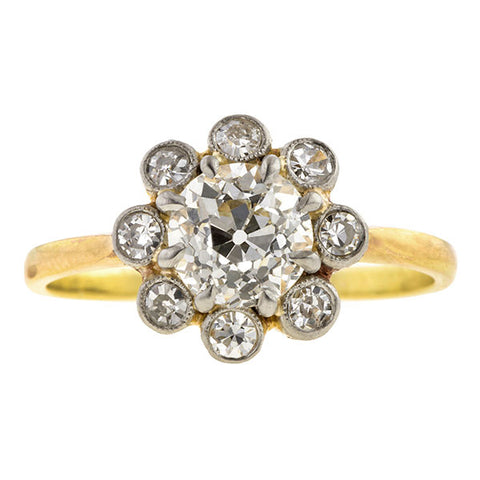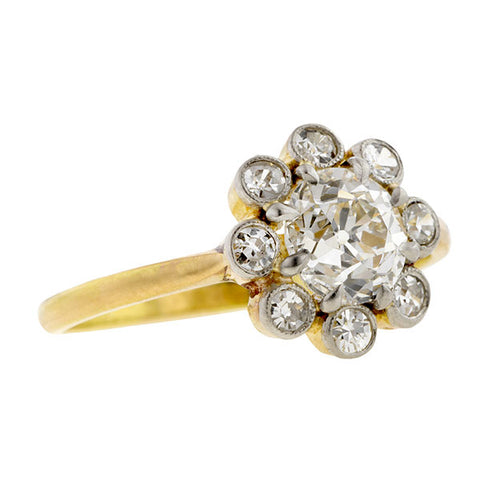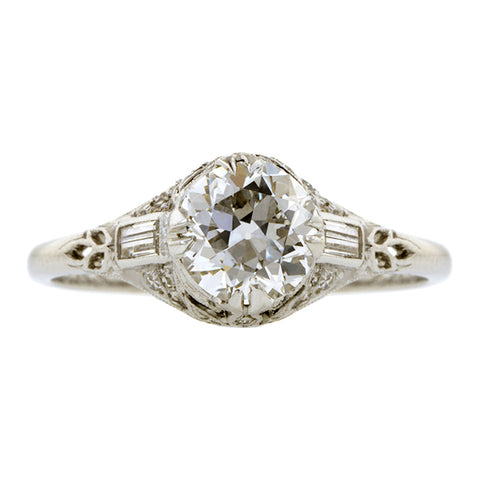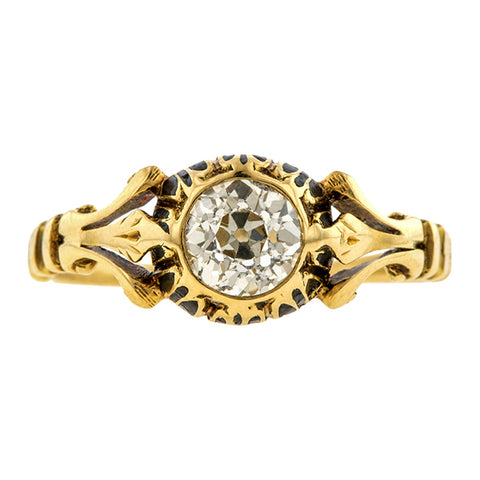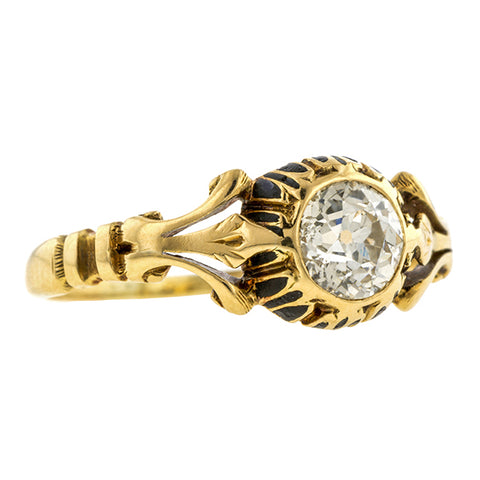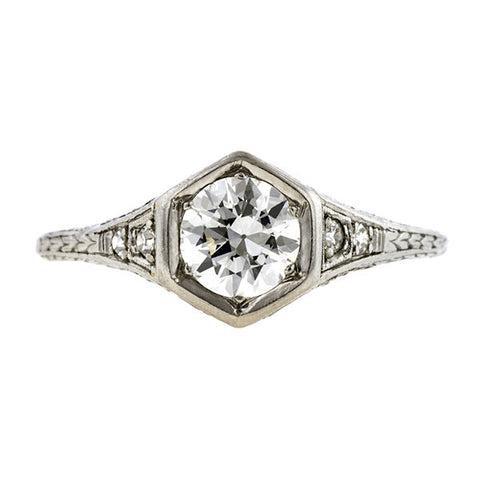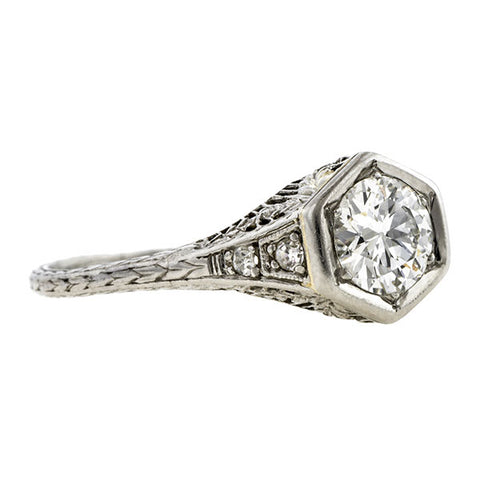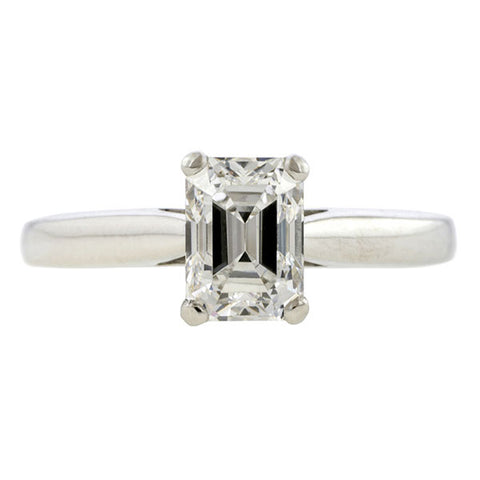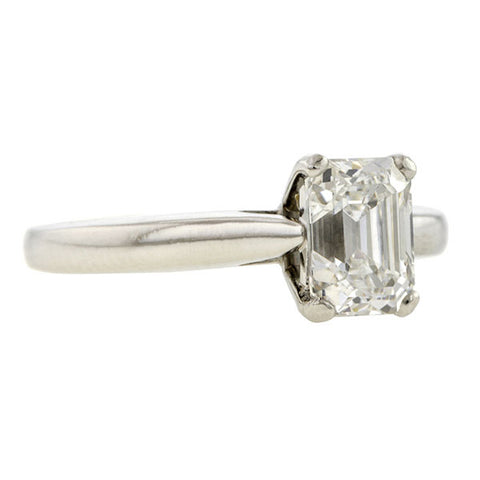Categories
Categories
Vintage, antique, and contemporary diamond engagement rings, all from Doyle & Doyle.
So you’re about to get engaged! But before we pop the bubbly, the next major decision (second to making the commitment to getting engaged, of course) is figuring out which engagement ring is perfect for you (or your soon-to-be life partner). And not just any ordinary engagement ring, either—a vintage one.
“The perk of a vintage ring is that there are less of them in the world, so you’re more likely to get a ring you don’t commonly see,” explains Pamela Doyle, one-half of the sister duo behind Doyle & Doyle, aka one of the most trusted vintage jewelry destinations in New York City. “Chances are if you’re at a cocktail party, your ring will be unique.”
But before you begin your search for the one at Doyle & Doyle (or any vintage jewelry boutique), there are a few things to keep in mind. For starters, not all old or secondhand rings are considered vintage—they fall under one of three categories: antique, when a piece is 100 years or older; vintage, when it’s 20 years or older; and estate, a pre-owned piece that’s no more than 20 years.

Doyle & Doyle gets in new engagement rings every week!
And because of the very nature of antique, vintage, or estate jewelry pieces, the source of its origin or its history may not be so readily available, which means it’s of the utmost importance to source your engagement ring from someone you trust. Factor in period styles and the whole process can be downright confusing.
“I think somebody could sell something that’s not accurate and do it not knowingly because they don’t have the experience or the bandwidth to do the research,” says Elizabeth Doyle, who fastidiously researches every single piece before it hits the floor, which can take about a month and rarely, even years. “I have a library in my office, I check the hallmarks, tool marks, setting styles—all the little details you can’t see—to make sure the pieces are as described. Additionally, we have three graduate gemologists on staff, and we provide diamond reports with all rings, so the color and clarity are verified by an independent lab.”
A trusted source is important, too, for future maintenance needs, from resizing to retipping prongs. (For all Doyle & Doyle purchases, you can send your piece back for repairs, even if you’ve moved away, Elizabeth promises). “Most of the time antique, vintage, or estate jewelry require specialized work to repair, so you don’t want to take it to somebody who doesn’t understand antique jewelry,” Elizabeth continues. “It needs to be done the right way with the right methods. It’s heartbreaking to see a ring ruined because that person didn’t know what they were doing.”

Beautiful details on vintage diamond solitaire engagement rings.
OK, so let’s talk money. A vintage (or antique or estate) engagement ring will be mostly priced based off the rarity and desirability of the design, along with the size, color, and clarity of the diamond. If you have a tight budget, Elizabeth advises to be flexible when it comes to the stone, like opting for a colored stone or a cluster of smaller diamonds as opposed to one large diamond. And if you still don’t see anything you like? New offerings make their debut every week (first on Instagram every Thursday, which are then available for purchase on Friday), and the Doyle sisters are always on-hand to personally help search for the perfect piece.
Now all that’s left is figuring out which ring from which time period is the right fit for your lifestyle. We broke down the eras and listed out the traits unique to each time period. Scroll through to find the one that speaks to you.
GEORGIAN (1714 to 1837)
What the rings look like: Smaller diamonds set in a closed back silver mounting (as in, it’s not open from behind) with a reflective foil behind them. Other elements of the ring, like the band, would be in gold.
Style characteristics: Edgy and alternative, especially because the silver darkens over the years.
It will suit you if: You’re more of a homebody with a non-active lifestyle. Georgian rings cannot get wet (if water gets into the mounting, it will deteriorate the foil behind the stone). That means you will have to take it off every time you wash your hands, which is fine if you’re at home, but the chances of loss are greater when you’re out in a public restroom.

Front and side views of a Georgian diamond engagement ring with crescent sides.
VICTORIAN (1837 to 1901)
What the rings look like: Generally, smaller stones set in yellow gold that are hand-engraved or hand-chased, with instances of enamel work.
Style characteristics: Usually ornate and bold.
It will suit you if: You’re careful with your jewelry—the pieces with enamel demand more care since they could break. Because the Victorian period has a long time span, there’s a wide variety of designs and price points (mass production of jewelry begins during this era).

Victorian diamond cluster engagement ring in a floral style.
ART NOUVEAU (1890-1910)
What the rings look like: Very stylized with whiplash lines and nature-inspired designs, like flowers, animals and bugs. Lots of glass enamel set in yellow gold.
Style characteristics: Fantastical and unconventional.
It will suit you if: You’re very non-traditional. An Art Nouveau engagement ring is very rare—even rarer, a diamond engagement ring. The movement favored design over precious materials and stones. And because of the presence of enamel, it’s important to be careful when wearing it (take it off before you work out or go rock climbing).

Naturalistic Art Nouveau diamond engagement ring with leafy sides.
EDWARDIAN (1901 to 1914)
What the rings look like: Very fine, intricate lacy designs crafted from platinum (this is the first period where you can find an all-white piece, thanks to the introduction to platinum).
Style characteristics: Incredibly feminine, frilly, and elaborate (think: threadbare thin lines).
It will suit you if: You’re careful with your hands (ideally for somebody with a desk job). Because of how delicate the designs are and the fact that very little metal is used (they’re hollow inside, too), banging your hands or dropping it can crush the filigree work.

Edwardian diamond engagement ring with a square, scalloped diamond frame.
ARTS & CRAFTS (1860 to 1920)
What the rings look like: Handmade designs mostly in silver (but there are instances of gold) with colored stones, crafted preferably by one artist from start to finish. Similar to Art Nouveau, this niche movement eschewed precious metals and materials in favor of design, workmanship, and artistry.
Style characteristics: Creative and unconventional with a degree of crudeness to the workmanship, because many of these artists were not traditionally trained jewelers.
It will suit you if: You love unique statement pieces. And because these rings tend to be heavier, stronger, and more robust, they can withstand a more active lifestyle.
ART DECO (1920-1935)
What the rings look like: Bold, geometric all-white designs with clean, straight lines, featuring baguettes and calibré cuts (small stones cut to precision, so they’re aligned perfectly). Popular accent stones include sapphires, rubies, and onyx.
Style characteristics: Clean and modern. It’s one of the most popular eras.
It will suit you if: You want a vintage ring that looks current. These designs are more robust, which means, it can work with nearly every lifestyle. Plus, it’s easy to seamlessly mix and match an Art Deco ring with a modern band or integrate it with jewelry you already own.

Front and profile views of an Art Deco diamond engagement ring with detailed engraving.
RETRO MODERNE (1937 to 1950)
What the ring looks like: Bigger, bolder geometric pieces in gold (platinum was hard to come by because of World War II). Jewelers had to make do with the resources they had, which meant reworking existing jewelry and mixing metals.
Style characteristics: Creative, almost eccentric designs. Think of it as next-level Art Deco.
It will suit you if: You love bold, over-the-top styles and are really into the idea of a cocktail ring as an engagement ring. Because of its size and bulk, a Retro Moderne ring is not ideal for someone who’s sporty or has to wear gloves often (if you’re a doctor of if you garden), unless you take it off.

Retro three diamond ring framed by rubies.
MID-CENTURY (1940s and 1950s)
What the ring looks like: Mostly all-white styles with a clean, simpler design (think: a more pared-down version of an Art Deco ring). Typically, you’ll find a center stone with baguettes on the side.
Style characteristics: Clean and streamlined. Most people who are looking for Art Deco will often end up with a Mid-Century ring.
It will suit you if: You’re a minimalist. Mid-Century rings are easy to wear (read: will fit most lifestyles) and mix well with current designs.

Vintage emerald cut diamond engagement ring with tapered baguette sides.



